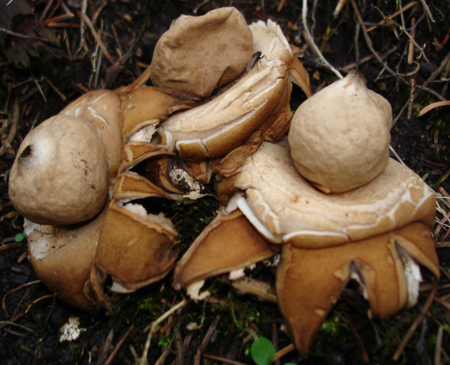The collared earthstar, Geastrum triplex Jung (formerly Geaster). These pictured specimens have the ‘collar’ typical of this species, which forms when the mesoperidium breaks apart during maturation of the fruit body. Despite what the common name might suggest, the presence of this character is not absolute, as humidity and temperature may inhibit collar development in some specimens.
Classification
Kingdom Fungi
Phylum Basidiomycota
Class Basidiomycetes
Order Phallales
Family Geastraceae
Genus Geastrum
Synonyms
Geastrum michelianum W.G. Sm. [as ‘Geaster‘], Gard. Chron.
London 18: 608 (1873)
Common names
Collared earthstar
Saucered earthstar
Kragen-Erdstern (German)
Géastre à trois couches (French)

My name is Austin Collins.
I've dedicated my life to Mushrooms.
I believe Mushrooms are the best kept secret when it comes to health and well being.
For that reason, I would like to share a company with you that in my opinion makes the best mushroom products on the market.
The company is called Noomadic Herbals, my favorite supplement they make is called "Mushroom Total".
I take their products every day and they have helped me think better and have more energy. Give them a try.
-Austin
Description
Like all taxa of the family Geastraceae, Geastrum triplex is a puffball-like saprobic fungus with a peridium composed of several layers. The exoperidium splits stellately (into star-shaped rays) during growth to expose the gleba-containing endoperidium underneath, which, after maturing, will later rupture open a pore at the apex. Spores may then be dispersed by means of circular air currents resulting from air blowing over the opening, or by water falling into the pore opening to splash the spores.
Fruiting body: up to 5 cm in diameter at widest part when unopened, spreading to up to 12 cm across. When young the fruit body may be partially buried (epigeal), more or less spherical or onion-shaped, not stalked, brown or reddish brown, the outer coat splitting at the apex into 4-8 uniform segments or rays, spreading back to form a star shape and often splitting into two layers of which the inner remains resemble a cup around the spore case.
Spore case: sessile, thin and papery, opening by a apical pore (ostiole) different in texture (fimbriate) from the rest of the smooth spore case (the peristome), smooth but somewhat fringed, typically seated in a slight depression.
Spores: brown, globose, ornamented, 3.5-5.5 μm.
Edibility: inedible.
Habitat: grows singly or gregarious on the ground in open coniferous and deciduous woods among leaf litter; fruting in summer-autumn, although persistent fruit bodies may be found year-round.
Distribution: the species has a widespead distribution, especially in temperate and subtropical regions. It has been reported in Brazil (Baseia et al., 2003), the Canary Islands, Spain (Eckblad, 1975), Chile (Viviana and Francisco, 1998), Congo (Dissing and Lange, 1962), Czechoslovakia (Kubat, 1972), Finland (Haeggstrom and Carlsson, 1999), the Galapagos Islands (Reid et al., 1980), Germany (Gerhardt, 1990), India (Nair and Patil, 1979), Iran (Saber, 1989), Mexico (Esqueda et al., 2003), Netherlands (Bollen, 2002), Panamá (Garner, 1956), Poland (Wojewoda, 2000), Sweden (Sunhede, 1977), Trinidad and Tobago (Reid, 1977), Ullung Island, South Korea (Jung, 1995), Venezuela (Dennis, 1960), and Zaire (Demoulin and Dring, 1975). In some of these locales it is considered a threatened species or species of conservation concern.
Bioactive compounds
The fruit bodies of Geastrum triplex Jungh contain the sterols ergosta-4,6,8,(14),22-tetraen-3-one,5,6-dihydroergosterol, ergosterol, peroxyergosterol, as well as myristic, palmitic, stearic, oleic, linoleic, and linolenic acids (Torpoco and Garbarino, 1998).
References
Baseia IG, Cavalcanti MA, Milanez AI. (2003).
Additions to our knowledge of the genus Geastrum (Phallales: Geastraceae) in Brazil.
Mycotaxon 85:409-15.
Bollen J. (2002).
Crown jewels and other mycological ornaments – 5: Hollow roads near the Bunderbos.
[Foreign Title: Kroonjuwelen en andere mycologische snuisterijen – 5: Holle wegen bij het Bunderbos.]
Coolia 45(4):198-200.
Dennis RWG. (1960).
Fungi venezuelani: III.
Kew Bulletin 14(3):418-458.
Henry D, Lange M. (1962).
Gasteromycetes of Congo.
Bulletin du Jardin botanique de l’État a Bruxelles 32(4):325-416.
Demoulin V, Dring DM. (1975).
Gasteromycetes of Kivu (Zaire), Rwanda and Burundi.
Bulletin du Jardin botanique national de Belgique/Bulletin van de National Plantentuin van België 45(3/4):339-372.
Eckblad F-E. (1975).
Additions and corrections to the gasteromycetes of the Canary Islands.
Norwegian Journal of Botany 22(4):243-248.
Esqueda M, Herrera T, Perez-Silva E, Sanchez, A. (2003).
Distribution of Geastrum species from some priority regions for conservation of biodiversity of Sonora, Mexico.
Mycotaxon 87:445-456.
Garner JHB. (1956).
Gasteromycetes from Panamá and Costa Rica.
Mycologia 48(5):757-764.
Gerhardt E. (1990).
Checkliste der Großpilze von Berlin (West) 1970-1990.
Englera 13:3-5+7-251.
Haeggstrom, C-A, Carlsson R. (1999).
The earthstar Geastrum triplex Jungh. found on Aland, SW Finland.
Memoranda Societatis pro Fauna et Flora Fennica 75(1):1-5.
Jung HS. (1995).
Fungal flora of Ullung Island: (VI). On ascomycetous, auriculariaceous, and gasteromycetous fungi.
Korean Journal of Mycology 23(1):1-9.
Kubat K. (1972).
Contribution to the geographic distribution of gasteromycetes in the Czechoslovakian Stredohori mountains. Part 2.
Ceska Mykologie 26(4):238-241.
Nair LN, Patil SD. (1979).
Fleshy fungi from western India. Part 1. Gasteromycetes.
Kavaka 5.
Reid DA, Pegler DN, Spooner BM. (1980).
An annotated list of the fungi of the Galapagos Islands.
Kew Bulletin 35(4):847-892.
Saber M. (1989).
New records of aphyllophorales and gasteromycetes for Iran.
Iranian Journal of Plant Pathology 259(1-4):21-26.
Sunhede S.
Morphology and intraspecific variation in Geastrum triplex Jungh.
Botaniska Notiser. 1977 130(4):403-16.
Torpoco V, Garbarino JA.
Studies on Chilean fungi. I. Metabolites from Geastrum triplex Jungh.
Boletin De La Sociedad Chilena De Quimica. 1998 43(2):227-9.
Reid D A. (1977).
Some gasteromycetes from Trinidad and Tobago.
Kew Bulletin 31(3):657-690.
Viviana E, Francisco S. (1998).
Arthropods associated to Geastrum triplex Jungh (Gasteromycetes, Basidiomycotina). V Region, Chile.
Acta Entomologica Chilena 22(0):97-109.
Wojewoda W. (2000).
New localities of rare and threatened species of Geastrum (Lycoperdales) in Poland.
Acta Mycologica. 35(2):145-151.




